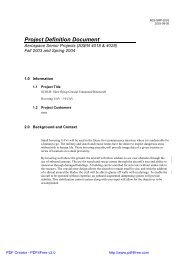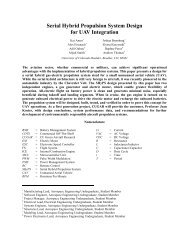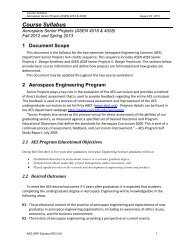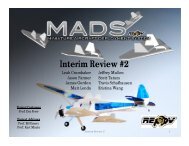PFR - Aerospace Engineering Sciences Senior Design Projects ...
PFR - Aerospace Engineering Sciences Senior Design Projects ...
PFR - Aerospace Engineering Sciences Senior Design Projects ...
Create successful ePaper yourself
Turn your PDF publications into a flip-book with our unique Google optimized e-Paper software.
Project Final Report – CUDBF April 30 th , 2009<br />
ASEN 4028: <strong>Aerospace</strong> <strong>Senior</strong> <strong>Projects</strong><br />
the takeoff roll and rotation. For any future asymmetric loads, the pilot decided to use some<br />
opposite aileron input to counteract the asymmetric load.<br />
13.2.2.14 Flight Test #21<br />
Flight test #21 was the first flight of the Buff-2C aircraft. The purpose of this flight test was to<br />
get the aircraft airborne and find out if there were any major issues before competition. The pilot<br />
reported the plane was trimmed, and that the aircraft had plenty of thrust at the lower density<br />
altitude.<br />
13.2.2.15 Flight Test #22 (Competition flight #1)<br />
The goal of this flight test was to successfully complete competition mission #1 at the DBF<br />
competition. The requirement tested was to complete two laps under 2:00. On this flight, the<br />
pilot pushed the aircraft harder than he ever had, and the time to complete two laps from takeoff<br />
to crossing the finish line was 1:43, 15 seconds faster than before. The flight ended in a good<br />
landing. A picture of the Buff-2C shortly after takeoff is shown in Figure 139.<br />
Figure 139: Buff-2C after takeoff on mission #1 at DBF competition<br />
13.2.2.16 Flight Test #23 (Competition flight #2)<br />
The goal of this flight test was to successfully complete competition mission #2 at the DBF<br />
competition. The two requirements to be tested were the 100ft takeoff with full payload weight,<br />
and the four lap range with full payload weight. The aircraft was able to lift off at approximately<br />
90ft, verifying the 100ft takeoff requirement at a 5,000ft density altitude. This was the distance<br />
that the aircraft was designed to takeoff in. After takeoff, the pilot noticed he was holding a lot of<br />
up elevator, and decided to reduce up elevator in order to avoid a stall. This caused the nose of<br />
the aircraft to drop significantly resulting in a crash.<br />
The primary reason for this crash was lack of pilot experience flying with the full water bottle. It<br />
was deemed a very risky flight, and there was very little time available to test fly with this<br />
152
















